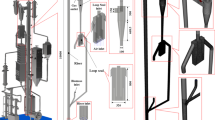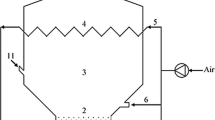Abstract
Gas/solid chemistry in the upper, dilute region of a circulating fluidised bed combustor (CFBC) riser is addressed. The limitations of turbulent mixing are illustrated by the example of the heterogeneous NO/CO/char reaction, relevant in CFB combustion of nitrogen-containing solid fuels. The mass transfer of the gaseous reactants to the char surface is determined, and how the conversion is influenced by the degree of mixing of the multiphase system by turbulent dispersion. Particle/turbulence interactions are taken into account by a (Lagrangian) frequency spectrum of velocity fluctuations, which determine the dispersion of the char particles described here with the Tchen–Hinze model. Chars from solid fuels characterised by fuel ratio (FR) ranging from 0.1 (wood) via 0.5 (peat) and 1 (coal A) to 2 (coal B) were considered. The effective rate of the NO/CO/char reaction is determined as a function of the size and type of the char particle, temperature, particle concentration, reactor dimensions and fluidization velocity, at atmospheric pressure.
It was found that for this case the effective gas/solid conversion rate in the upper, dilute region of the riser is much lower than the gas/solid chemistry, mainly due to mass transfer limitations for char particles with sizes of typically 300 μm. The concentration of NO at the char particle surface is only a few % of that in the bulk gas phase. Strong influences were found for particle size and temperature, whilst the fluidisation velocity and the reactor size have only a small influence. It is concluded that for a typical CFB riser, for particles larger than approx. 20 μm, mass transfer has a stronger influence on the heterogeneous NO/CO/char reduction mechanism than the ``unmixedness'' due to particle eddy dispersion limitations. It is recommended that this or a similar approach to turbulent dispersive mixing is implemented in CFD codes when these are used for boiler and furnace calculations.
Similar content being viewed by others
Author information
Authors and Affiliations
Rights and permissions
About this article
Cite this article
Zevenhoven, R., Järvinen, M. Particle/Turbulence Interactions, Mass Transfer and Gas/Solid Chemistry in a CFBC Riser. Flow, Turbulence and Combustion 67, 107–124 (2001). https://doi.org/10.1023/A:1014023320280
Issue Date:
DOI: https://doi.org/10.1023/A:1014023320280




